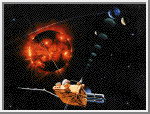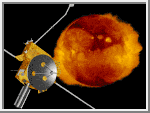











|
ESA/NASA Solar Probe
Courtesy of ESA and NASA
| Introduction |
|---|
Ulysses is a solar probe launched in 1990 that has made the first-ever measurements of the Sun from a polar orbit. In route to solar polar orbit, it made a close flyby of Jupiter and made measurements of the solar system's largest planet.
Formerly called the International Solar-Polar Mission (ISPM), Ulysses is an exploratory mission carried out jointly by ESA and NASA. The European contribution to the Ulysses program consists of the provision and operation of the spacecraft, and about half of the experiment. NASA provided the launch aboard the Space Shuttle Discovery (together with the upper-stage motor) and the spacecraft power generator, and is responsible for the remaining experiments. NASA also supports the mission using its Deep Space Network ( DSN). The original mission planned for two spacecraft, one built by NASA and the other by ESA. NASA canceled its spacecraft in 1981.
Secondary objectives of the mission include interplanetary-physics investigations during the in-ecliptic Earth/Jupiter phase, measurement in the Jovian magnetosphere during the Jupiter encounter, the detection of cosmic gamma-ray bursts, and a search for gravitational waves.
Besides the on-board experiments, the spacecraft and ground telecommunications systems have been used to conduct radio-science investigations. In addition, interdisciplinary investigations that use data from more than one Ulysses experiment to address specific questions of out-of-ecliptic science are being carried out.
All spacecraft systems and the nine sets of instruments that make up the scientific payload have been functioning well and has survived the potentially dangerous flight through Jupiter's magnetosphere. Spacecraft operations, conducted by the joint ESA-NASA Mission Operations Team located at the Jet Propulsion Laboratory, have proceeded smoothly, with the exception of four occurrences of a 'Disconnect Non-Essential Loads' (DNEL) condition on board the spacecraft. DNELs occur when the on-board protection logic places the spacecraft in a minimum current demand mode by disconnecting the scientific payload in response to a violation of overcurrent criteria. It is likely that the DNEL condition, which has on each occasion occurred in conjunction with a routine Earth-pointing maneuver, is associated with operation of the latching valve when this coincides with unpredictable peaks in payload current demand. In all cases, the spacecraft was restored to its nominal operational configuration without incident, with the majority of instruments suffering less than 24 hours outage.
The only other problem of any significance has been a nutation-like motion which built up following deployment of the 7.5-meter (25-foot) axial radio wave experiment antenna shortly after launch. This disturbance was apparently driven by asymmetric solar heating of the axial boom as the spacecraft spun and was of a temporary nature, damping out once the boom was permanently in the shadow of the spacecraft body. The nutation is predicted to return during the high-latitude phase of the mission, and operational measures utilizing the on-board Conscan system have been developed to suppress the motion. In order to exploit the damping provided by Conscan, continuous ground station coverage is needed. As a result, the ESA ground station in Kourou has been upgraded to augment the DSN during periods of potential nutation, the DSN having only one station in the southern hemisphere.
Continuity of the scientific data--a prime scientific requirement for the mission--has been very good, data coverage exceeding 95% for the greater part of the mission to date.
| Views of Ulysses |
|---|
 Ulysses
l
Ulysses
l
This image shows the Sun as seen by an X-ray
telescope, the Ulysses spacecraft, and the Earth-Moon system.
(Courtesy NASA/JPL)
 Ulysses at Sun's Pole
Ulysses at Sun's Pole
The Ulysses is the first spacecraft to explore the third dimension of
space over the poles of the Sun. Scientists have found some surprising
new discoveries about the polar regions of the Sun when the spacecraft
passed over the regions in 1994 and 1995. The spacecraft revealed two
clearly separate and distinct solar wind regimes, with fast wind
emerging from the solar poles.
Scientists were surprised by observations of how cosmic rays make their way into the solar system from galaxies beyond the Milky Way. The magnetic field of the Sun over its poles turned out to be very different from previous expectations using ground-based observations. In addition, Ulysses found a beam of particles from interstellar space that was penetrating the solar system at a velocity of close to 80,000 kilometers per hour (50,000 miles per hour).
On September 29, 1995, Ulysses completed its first solar orbit
and began its voyage back out to the orbit of Jupiter, where it
will loop around and return to the vicinity of the Sun in
September 2000. At that time the Sun will be in a very active
phase of its 11-year solar cycle and Ulysses will find itself
battling through the atmosphere of a star that is no longer
docile.
(Courtesy NASA/JPL)
| References |
|---|
ESA's Report to the 30th COSPAR Meeting, Hamburg, Germany, July 1994, European Space Agency, Paris, 1992, pp. 47-57.
Planetary Science Database, National Space Science Data Center (NSSDC), National Aeronautics and Space Administration, Greenbelt, Maryland. World Wide Web: http://nssdc.gsfc.nasa.gov/nssdc/nssdc_home.html.